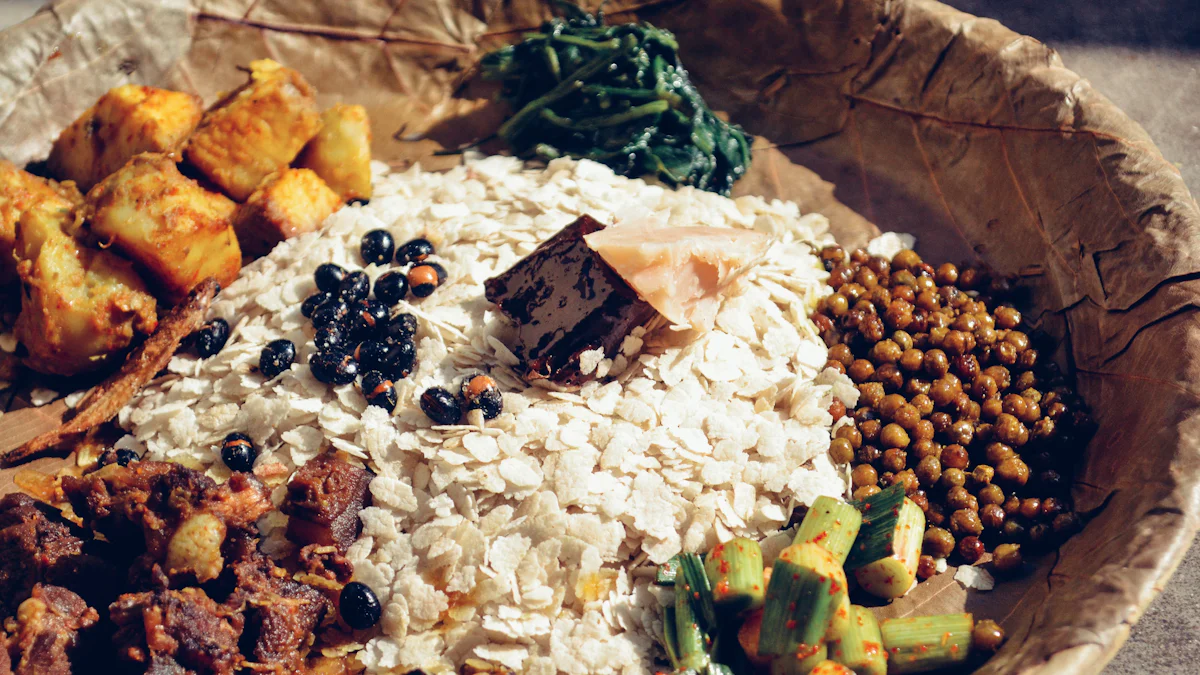Caring for dogs with kidney disease requires a specialized diet, including homemade dog food for kidney disease. This tailored diet can reduce the strain on the kidneys, potentially slowing down the progression of the disease. Studies have demonstrated that dogs following these dietary guidelines tend to have longer and healthier lives. By preparing meals at home, I can control the levels of protein, phosphorus, and sodium, while also incorporating beneficial omega-3 fatty acids to support kidney function and enhance overall well-being.
Important Ingredients for Homemade Dog Food
Safe Proteins
Chicken and Turkey
When making dog food for kidney disease, I use safe proteins. Chicken and turkey are great picks. These meats give important amino acids without too much phosphorus. Using skinless poultry helps my dog get nutrients while protecting their kidneys.
Fish Choices
Fish is another good protein source. I add fish like salmon or whitefish to my dog’s meals. These have omega-3 fatty acids that help kidneys and health. Fish gives balanced protein to keep muscles strong without stressing the kidneys.
Vegetables and Grains
Good Vegetables
Adding vegetables is key in my dog’s diet. I pick low-phosphorus veggies safe for kidney issues like:
- Cabbage
- Cauliflower
- Cucumber
- Green beans
- Bell peppers
- Zucchini
- Carrots
- Leafy greens
These veggies make meals interesting and give vitamins and minerals. They help the kidneys by offering nutrients with little phosphorus.
Grain Options
Grains can be part of a healthy diet for kidney disease dogs. I choose grains gentle on kidneys, like quinoa and barley. They provide fiber and energy without high phosphorus levels found in other grains. These grains ensure my dog gets a balanced meal for good health.
Crockpot Dog Food for Kidney Disease
Using a crockpot to make dog food is helpful. Slow cooking makes the food taste better. This helps dogs who don’t feel like eating much. Even picky dogs will enjoy these meals. Dogs with kidney problems might not eat well, so tasty food helps them eat more.
Benefits of Crockpot Cooking
- Flavor Boost: Slow cooking mixes flavors well. It makes the dish smell good and can make dogs want to eat.
- Keeps Nutrients: Gentle cooking keeps important nutrients in the food. Dogs with kidney disease need these nutrients for health.
- Easy to Use: A crockpot is easy to use. I start it in the morning, and by evening, dinner is ready. It saves time and gives my dog a homemade meal without much work.
Personal Experience
My dog stopped needing spoon feeding and started eating again. With homemade toppings, she eats a lot now! She runs when it’s time to eat because of the yummy smell.
This shows how crockpot meals help dogs eat better and feel good. The nice smell and taste change their eating habits.
Key Ingredients for Crockpot Meals
- Lean Proteins: Use chicken, turkey, or fish for protein. These are good for kidneys.
- Vegetables: Add veggies like carrots, green beans, and zucchini for vitamins.
- Grains: Choose grains like quinoa or barley for fiber without too much phosphorus.
A crockpot ensures my dog gets healthy meals that fit their needs. This way supports their kidney health and improves their life quality.
Nutritional Needs for Dogs with Kidney Disease
Important Nutrients to Add
Low-Phosphorus Foods
I use foods low in phosphorus for my dog’s kidneys. Less phosphorus helps the kidneys work less hard. I pick things like white rice and pasta. These help slow kidney disease.
Omega-3 Fats
Omega-3 fats are important for my dog. They help the kidneys and health overall. I add fish oil or flaxseed to meals. This helps reduce swelling and supports the heart.
Foods to Avoid
High-Sodium Items
I avoid foods with lots of salt. Too much salt can raise blood pressure and hurt kidneys. I choose fresh food, not processed ones. This keeps my dog healthy.
High-Protein Foods
Too much protein is bad for dogs with kidney issues. I give lean meats like chicken and turkey instead. This way, my dog gets nutrients without stressing the kidneys.
Low Fat and Protein Dog Food
Making food with low fat and protein for my dog with kidney disease needs careful ingredient choices. This helps control weight and eases kidney work. I aim for balanced meals that my dog likes.
Why Pick Low Fat and Protein?
- Kidney Support: Less protein means less strain on kidneys. It stops waste buildup that harms kidneys.
- Weight Management: Low-fat diets keep weight healthy. This is key for dogs with kidney issues, as extra weight can make things worse.
- Digestive Health: A diet with moderate protein and fat aids digestion. It helps my dog get nutrients without stressing kidneys.
Key Ingredients for Low Fat and Protein Diets
- Lean Proteins: I use lean meats like chicken and turkey. They give needed amino acids without too much fat or phosphorus.
- Vegetables: Adding veggies like carrots, green beans, and zucchini gives fiber and nutrients. They are low in phosphorus, helping kidneys stay healthy.
- Grains: Grains like quinoa and barley provide energy and fiber. They are easy on the kidneys, making a balanced meal.
Comparing Low Fat Dog Foods
When choosing store-bought options, I compare brands to find the best match for my dog’s needs:
- Fat Content: I look for foods with less fat. Brands like Eagle Pack’s Reduced Fat Dog Food and Annamaet Lean Reduced Fat are good choices.
- Protein Levels: Balancing protein is important. I pick foods with moderate protein to help kidney health.
- Grain Inclusion: Some brands have grains; others don’t. I choose based on what my dog likes and needs.
Personal Experience
Switching to a low-fat, low-protein diet boosted my dog’s energy levels. She got more active and showed fewer signs of kidney trouble.
This shows how a special diet helps health. By choosing low fat and protein, I support my dog’s well-being effectively.
Benefits of Homemade Dog Food for Kidney Disease
Control Over Ingredients
Making dog food at home lets me pick all the ingredients. I choose fresh, good foods that help my dog’s health. I can change recipes to fit my dog’s needs. For example, I adjust protein and add low-phosphorus veggies for kidney help. This isn’t possible with store-bought food.
Customizing Recipes
I make meals to match what my dog likes and needs. If my dog prefers chicken over fish, I switch it easily. This way, my dog gets nutrients and enjoys eating. Changing recipes also helps avoid allergies.
Ensuring Freshness
Fresh food is a big plus of homemade meals. I use fresh items so my dog gets full nutrition. Fresh foods improve hair, skin, and energy. Making meals at home means no preservatives like in store foods.
Cost-Effectiveness
Homemade food can cost less than special store diets. Buying ingredients might seem pricey first but saves money later. Buying in bulk and using seasonal items cuts costs while keeping quality high.
Comparing with Commercial Diets
Store diets for kidney issues are costly. Making food at home saves money and ensures quality ingredients go into meals. Homemade meals skip hidden costs like fillers in store foods.
Long-Term Savings
Over time, homemade food saves a lot of money. Using good ingredients lowers vet bills from diet problems. A balanced diet keeps my dog healthy, reducing expensive treatments needed later.
Step-by-Step Guide to Making Homemade Dog Food for Kidney Disease
Planning the Diet
Talking to a Vet
I always talk to a vet first. They give advice for my dog’s needs. Vets at Beyond Pets Animal Hospital stress getting expert help for dogs with kidney disease. This helps me pick good ingredients and skip bad ones.
Making a Balanced Meal Plan
After the vet’s tips, I make a meal plan. I use safe proteins, low-phosphorus veggies, and healthy grains. This plan keeps my dog’s diet steady and full of nutrients.
Cooking Techniques
Safe Ways to Cook
I cook safely to keep nutrients in the food. Steaming and boiling are best. These ways keep food healthy for my dog. Slow cooking in a crockpot makes meals taste better too.
Storing and Giving Food
Storing right is key. I put cooked meals in closed containers in the fridge. This keeps them fresh and safe. When serving, I make sure it’s room temperature so my dog likes it more and can digest it easily.
“Made by vets at Beyond Pets Animal Hospital, this recipe uses simple ingredients that can be pre-cooked and mixed for balanced meals.”
By doing these steps, I give my dog healthy homemade meals that help their kidneys stay strong.
Sample Recipes for Dogs with Kidney Disease

Making homemade dog food is simple and healthy. These recipes help kidney health. Here are two easy recipes I use for my dog.
Recipe 1: Chicken and Rice
Ingredients and Preparation
For this dish, you need:
- 1 cup cooked white rice
- 1/2 pound skinless chicken breast
- 1/2 cup chopped carrots
- 1/2 cup green beans
- 1 tablespoon fish oil
Steps:
- Boil the chicken until done. Shred it.
- Cook rice as directed on the package.
- Steam carrots and green beans until soft.
- Mix chicken, rice, and veggies in a bowl.
- Add fish oil and stir well.
Nutritional Benefits
This meal has low phosphorus with lean chicken protein. Rice gives easy carbs, while veggies add vitamins and fiber. Fish oil gives omega-3s for kidneys.
Recipe 2: Fish and Sweet Potato
Ingredients and Preparation
You need:
- 1/2 pound whitefish (like cod)
- 1 cup cooked sweet potato
- 1/2 cup zucchini
- 1/2 cup cauliflower
- 1 tablespoon flaxseed oil
Steps:
- Bake fish at 350°F until flaky.
- Boil sweet potato, mash it.
- Steam zucchini and cauliflower until soft.
- Mix fish, sweet potato, and veggies in a bowl.
- Drizzle flaxseed oil over it; mix well.
Nutritional Benefits
This meal has omega-3s from fish for kidneys. Sweet potatoes give vitamins; zucchini adds fiber; flaxseed oil gives healthy fats.
These recipes are nutritious and easy to make. They let me control ingredients so my dog gets a balanced diet for their needs. Homemade food helps keep my dog healthy!
Monitoring Your Dog’s Health
Signs of Improvement
Increased Energy Levels
I notice when my dog has more energy. She plays more and seems happier. This shows her diet is helping her kidneys. Watching her energy helps me know if the food is working.
Better Appetite
A better appetite is a good sign. My dog eats more eagerly now. She finishes her meals without fuss. This tells me her body feels better and the diet suits her needs.
When to Consult a Veterinarian
Recognizing Warning Signs
I stay alert for warning signs. If my dog seems tired or refuses food, I worry. Changes in urination or weight loss also concern me. These signs mean I should talk to the vet.
Adjusting the Diet
Sometimes, I need to change the diet. If my dog shows warning signs, I consult the vet. They help me adjust the meal plan. This ensures my dog gets the right nutrients for her condition.
Diet is key for dogs with kidney problems. Making meals at home means fresh, healthy food. I talk to a vet to make sure the diet fits my dog’s needs. Homemade food helps energy and makes fur shiny. This way, I know what’s in each meal and feel good about it.

